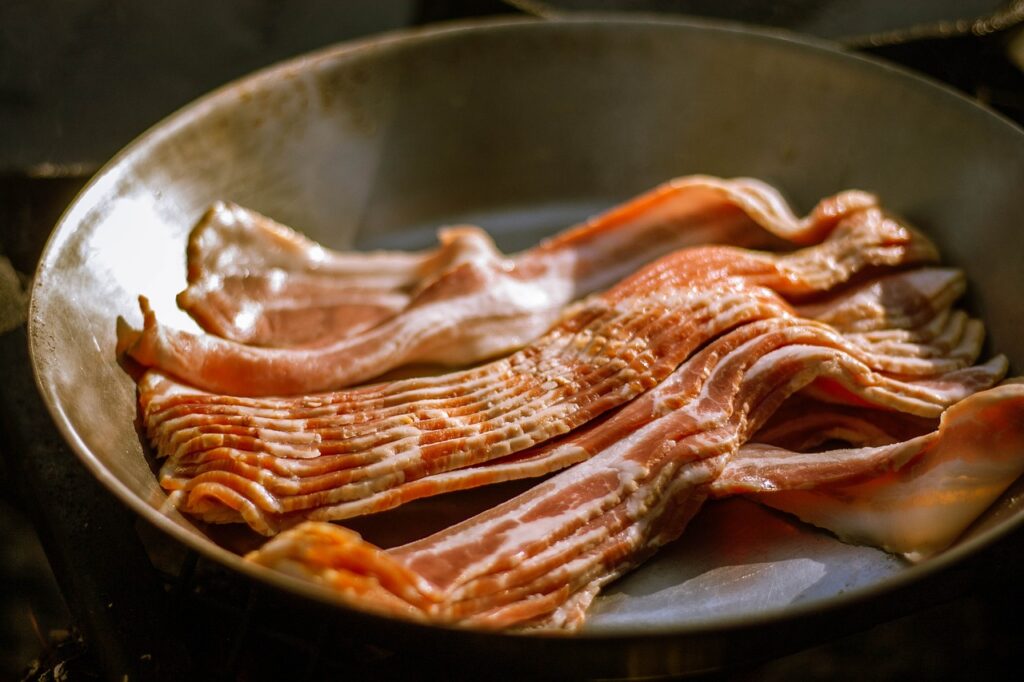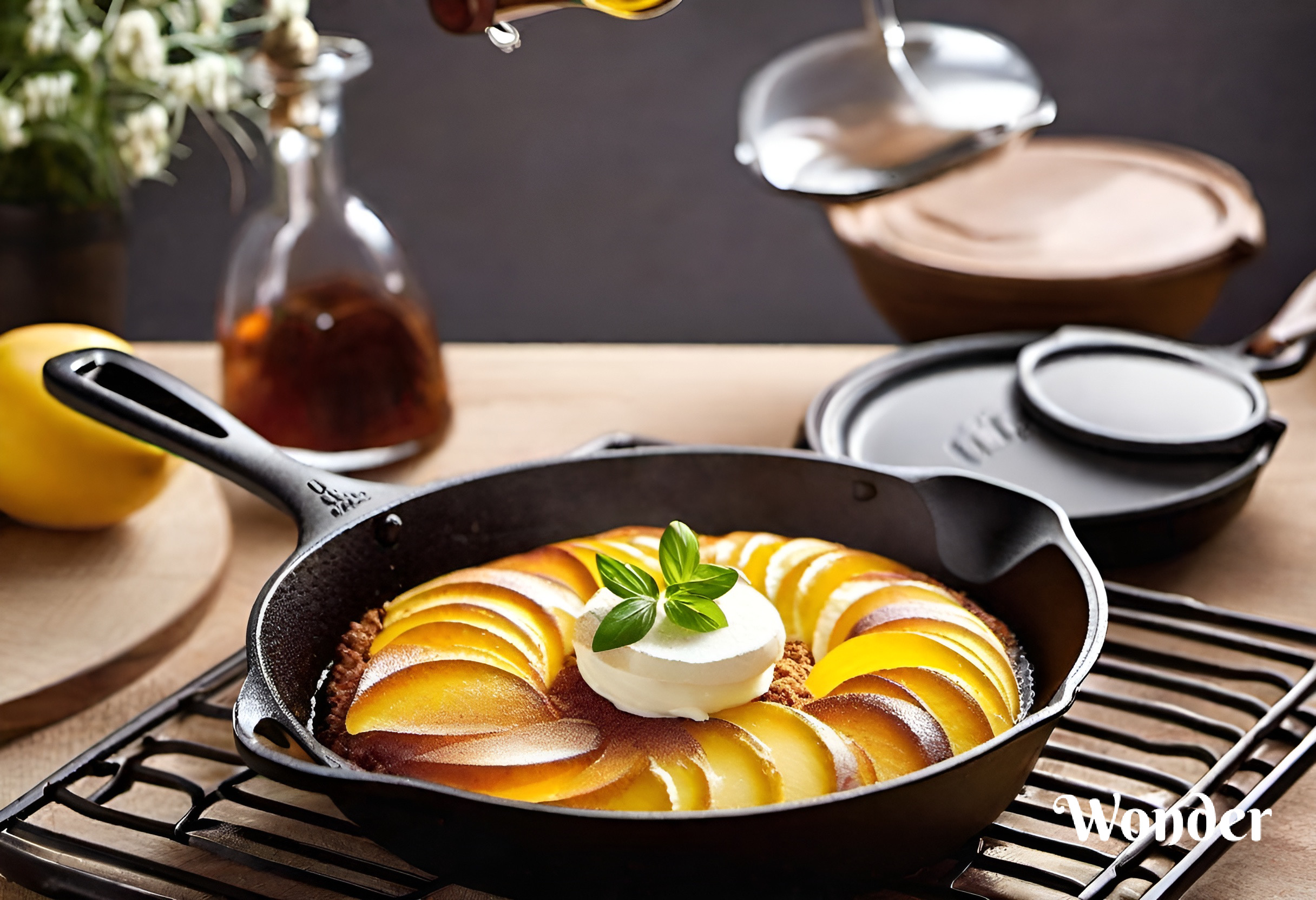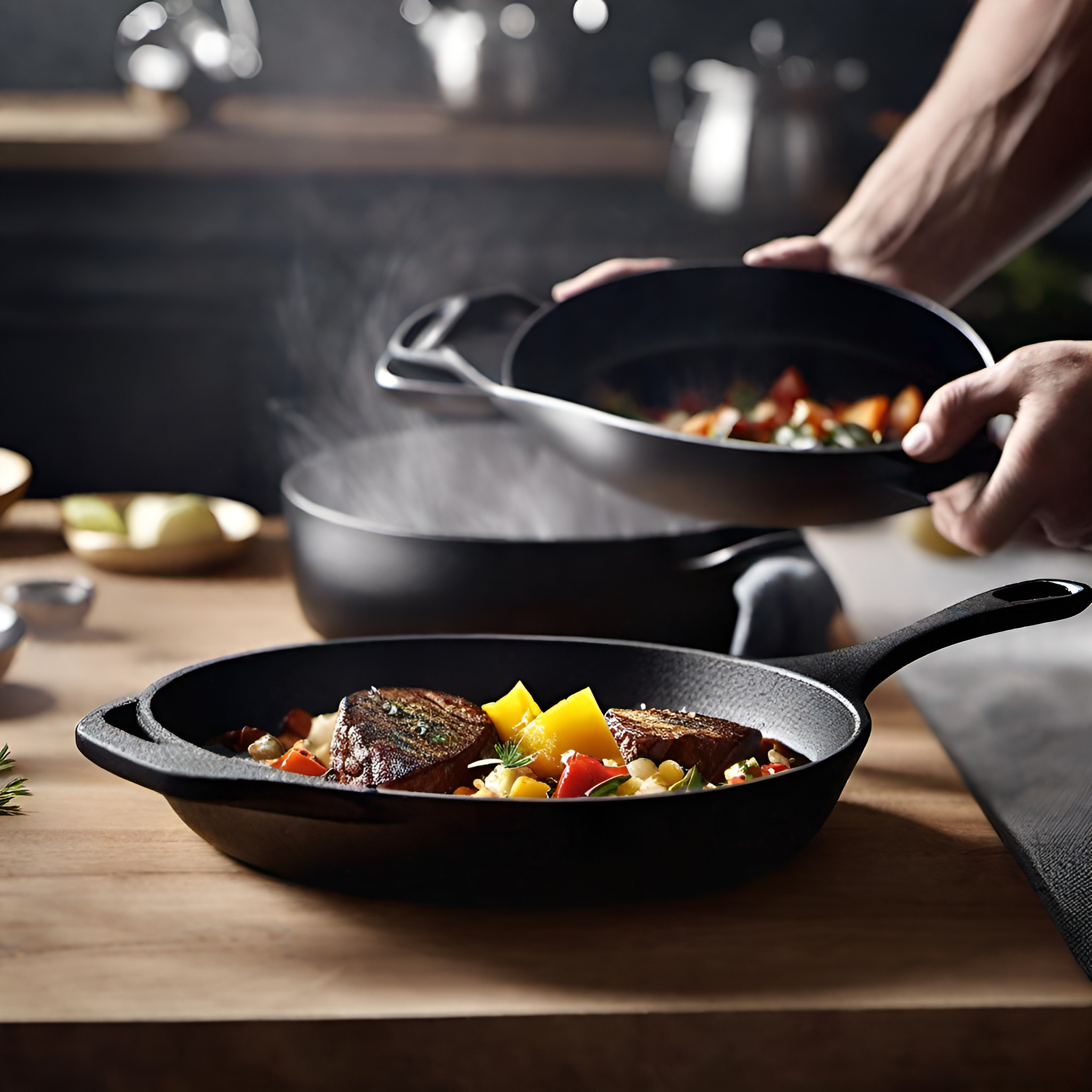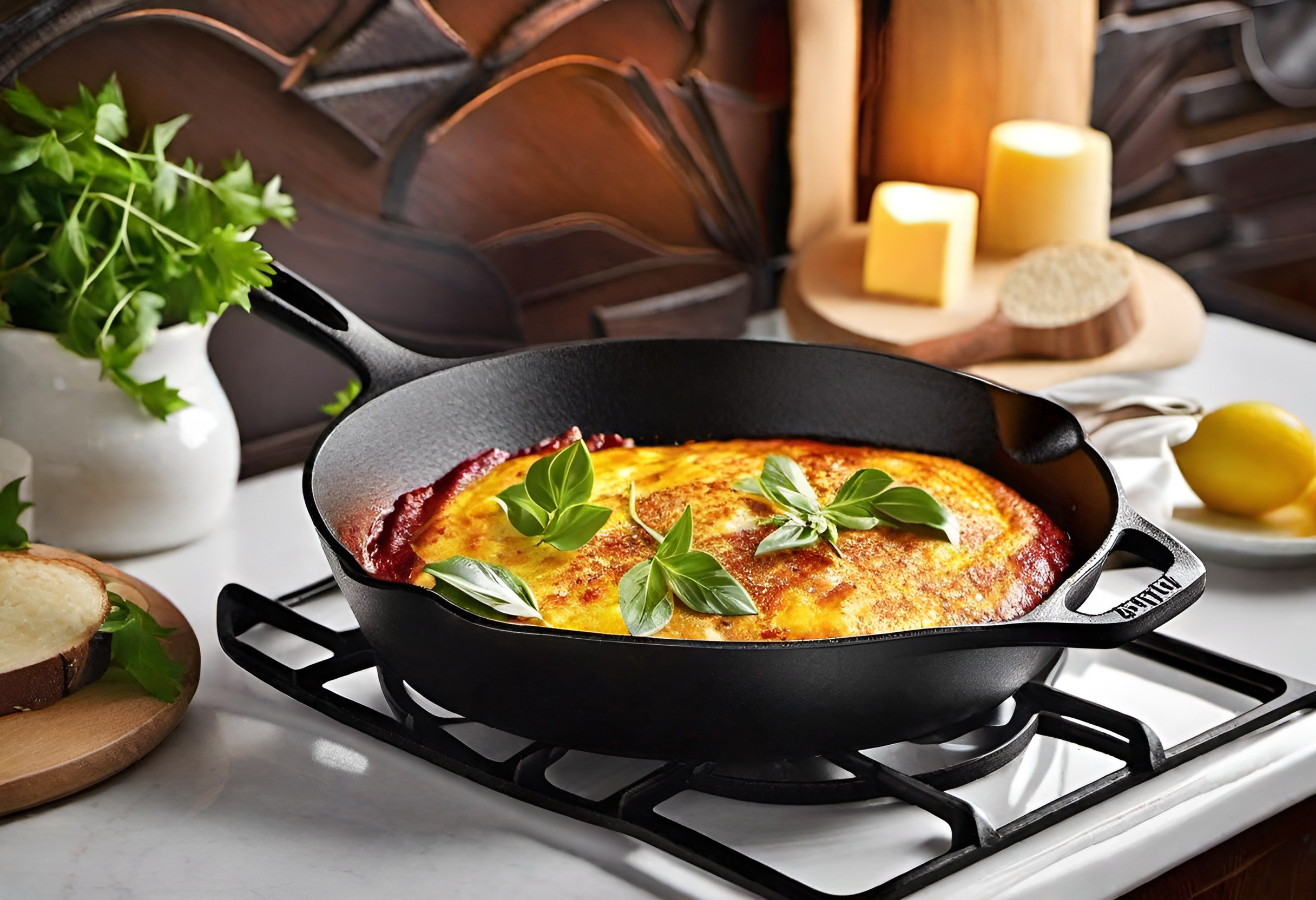“The Durability and Longevity of cast iron pans” explores the suitability of cast iron pans in different cooking scenarios and determines if they can be considered the best choice. This article evaluates key factors such as heat retention and distribution, durability and longevity, versatility, maintenance and care, health and safety, cost and accessibility.
The methodology involves gathering data from scientific studies, expert opinions, and user reviews, followed by analysis and comparative assessment. By following this framework, you can systematically determine if cast iron pans are the best choice for your specific culinary needs, considering various factors and contextual elements.
A. Heat Retention and Distribution

This image is property of pixabay.com.
Analyze the capacity of cast iron to retain and distribute heat evenly
Cast iron has long been recognized for its superior heat retention and distribution capabilities. The dense material of cast iron allows it to absorb and store heat effectively, ensuring that the pan remains hot even when food is added.
This property makes it ideal for dishes that require high and consistent temperatures, such as steaks or stir-fries.
When heated, cast iron pans distribute the heat evenly across the cooking surface. This eliminates hot spots and ensures that the food is cooked uniformly. The ability to distribute heat evenly is particularly important for dishes that require precise cooking, such as delicate fish fillets or baked goods.
Compare it with other popular cookware materials (e.g., stainless steel, non-stick) regarding heat performance
In comparison to other popular cookware materials like stainless steel and non-stick pans, cast iron excels in heat performance. Stainless steel pans are known for their poor heat retention, often resulting in uneven cooking.
They require a preheating process to compensate for this drawback. On the other hand, cast iron pans retain heat for a longer period, reducing the need for constant temperature adjustments during the cooking process.
Non-stick pans, while convenient for certain types of cooking, generally do not retain heat as effectively as cast iron. They tend to have thinner and less conductive construction, which can lead to hot spots and inconsistent heat distribution. This can result in unevenly cooked food, which may be frustrating for individuals seeking precise cooking outcomes.
Overall, when it comes to heat retention and distribution, cast iron pans outperform other common cookware materials, providing consistent and reliable heat for a variety of cooking techniques.
B. Durability and Longevity
Examine the durability of cast iron pans over time
One of the standout features of cast iron pans is their exceptional durability. These pans are built to withstand heavy use and can last for generations when properly cared for. The thick and sturdy construction of cast iron makes it resistant to warping and bending, ensuring that it maintains its shape and functionality even with regular use.
Evaluate their resistance to wear, rust, and deformation
Cast iron pans are known for their remarkable resistance to wear, rust, and deformation. The natural seasoning that occurs over time helps protect the pan’s surface from developing rust.
However, it is essential to properly clean and season the pan to maintain its protective layer.
With regards to wear and deformation, cast iron pans are highly resilient. They can handle high heat, making them suitable for various cooking methods, including stovetop and oven use.
The durability of cast iron means that it can withstand heavy utensil use without scratching or damaging the pan’s surface.
In comparison, other types of pans, such as non-stick pans, often have a limited lifespan due to the non-stick coating wearing off over time. Stainless steel pans, while durable, may not be as resistant to rust and wear as cast iron.
Compared with the longevity of other types of pans
When it comes to longevity, cast iron pans are unmatched. With proper care and maintenance, they can last for decades and even be passed down through generations. This longevity makes cast iron pans an excellent investment for those looking for cookware that will stand the test of time.
In contrast, non-stick pans typically have a shorter lifespan due to the wear and tear of the non-stick coating. Stainless steel pans, while durable, may show signs of wear and scratches over time, affecting their appearance and potentially compromising their performance.
C. Versatility
Explore the range of dishes that can be prepared using cast iron
Cast iron pans are incredibly versatile and can be used to prepare a wide range of dishes. Their ability to retain and distribute heat evenly makes them suitable for various cooking methods, including frying, baking, searing, and roasting.
For frying, cast iron pans provide excellent temperature control, allowing for crispy and evenly browned results. Their heat retention properties also make them ideal for searing meats, creating a beautiful crust while locking in juices.
In baking, cast iron pans offer excellent heat distribution, ensuring even the cooking of cakes, bread, and other baked goods. Their ability to retain heat also helps to create a golden crust on the bottom, enhancing the texture and flavor of baked goods.

Assess the adaptability of cast iron pans in various cooking methods (e.g., frying, baking, searing, roasting)
Cast iron pans can seamlessly transition from stovetop to oven, making them versatile tools in the kitchen. They can be used for baking cornbread, cooking casseroles, or even baking pizzas due to their ability to withstand high temperatures. This versatility allows home cooks and professional chefs alike to experiment with different cooking techniques and explore a wide range of culinary possibilities.
Compared to other materials, cast iron pans offer greater versatility. Non-stick pans, while suitable for some cooking methods, may not be oven-safe and are not recommended for high-heat applications like searing. Stainless steel pans can be versatile but may require additional preheating to achieve the desired results due to their lower heat retention.
In summary, cast iron pans are highly adaptable and excel in various cooking methods. Their versatility makes them a valuable addition to any kitchen.
D. Maintenance and Care
Describe the maintenance requirements of cast iron cookware
Proper maintenance is crucial to ensure the longevity and performance of cast iron cookware. After each use, it is recommended to clean the pan while it is still warm. This can be done by using a scrub brush or a non-abrasive sponge and mild dish soap.
Avoid using harsh chemicals or soaking the pan for extended periods as this can damage the seasoning.
Once the pan is clean, it should be thoroughly dried to prevent the formation of rust. Towel drying and placing the pan on low heat can aid in the drying process. It is essential to ensure that the pan is completely dry before storing it to prevent moisture from causing rust.
To maintain the seasoning, which is a natural non-stick coating that develops over time, cast iron pans need to be periodically seasoned. This can be done by applying a thin layer of vegetable oil or flaxseed oil to the entire surface of the pan and heating it to a specific temperature.
Seasoning helps protect the pan from rust and enhances its non-stick properties.
Evaluate the ease of cleaning and seasoning cast iron compared to other materials
While cast iron pans require specific maintenance, they can be relatively easy to clean and season when done regularly. The process of cleaning and seasoning becomes more straightforward with time and practice, becoming an essential routine in maintaining the pan’s performance.
In comparison, non-stick pans are generally easier to clean as food particles are less likely to stick to the surface. However, the non-stick coating can wear off over time, requiring the pan to be replaced. Stainless steel pans may require more effort to clean, as food can stick to the surface if not properly managed.
While the initial steps of cleaning and seasoning cast iron pans may seem more involved than other cookware materials, the long-term benefits and durability make it worth the effort.
E. Health and Safety

Investigate the potential health concerns related to the use of cast iron
Using cast iron cookware offers several health benefits. Iron, a mineral essential for the body, can leach into food cooked in cast iron pans. This can contribute to increasing iron intake, particularly for individuals with iron deficiencies. However, it is worth noting that excessive iron intake can be harmful, so it is important to maintain a balanced diet and consult a healthcare professional for personalized advice.
Despite these benefits, some individuals may have concerns about the potential for cast iron pans to leach other metals into food. When properly seasoned and maintained, cast iron pans have a protective layer that prevents direct contact between food and the iron surface, minimizing the risk of metal leaching.
Compared with the safety aspects of alternative cookware materials
Other cookware materials such as non-stick pans and stainless steel pans have their own safety considerations. Non-stick pans may release toxic fumes if overheated or if the non-stick coating starts to wear off. Stainless steel pans, while generally safe to use, may pose a risk if they contain nickel or other allergenic metals that could leach into food.
Cast iron pans, when properly seasoned and maintained, can provide a safe and reliable cooking experience. It is crucial to follow appropriate seasoning and cleaning techniques to ensure the pan’s protective layer remains intact, minimizing the potential for any health risks.
F. Cost and Accessibility
Analyze the cost of acquiring and maintaining cast iron pans
Cast iron pans are generally affordable and offer excellent value for money. They are available in a wide range of price points, making them accessible to different budgets. Additionally, cast iron pans’ exceptional durability and longevity contribute to their cost-effectiveness, as they can last for decades with proper care.
Maintaining cast iron pans requires some additional effort compared to other materials, but the associated costs are minimal. Seasoning the pan can be done with inexpensive oils, such as vegetable oil or flaxseed oil, and regular cleaning can be achieved with basic dish soap and water.
Compare the accessibility of cast iron pans with other types of cookware
Cast iron pans are widely accessible and can be found in most kitchenware stores, department stores, and online retailers. They are available in various sizes and styles, catering to different cooking needs and preferences. The widespread availability of cast iron pans ensures that individuals can easily incorporate them into their kitchen arsenal.
While other cookware materials like non-stick pans and stainless steel pans are also readily available, they may come at higher price points, especially for high-quality brands. The cost and accessibility of cast iron pans make them an attractive option for individuals looking to invest in durable and reliable cookware without breaking the bank.
Methodology
Specify the research methods and sources of data (e.g., scientific studies, expert opinions, user reviews) to be used for evaluation
For the evaluation of cast iron pans, a comprehensive approach utilizing a variety of research methods and sources of data will be employed. The assessment will draw upon scientific studies, expert opinions from reputable sources, and user reviews to gather a well-rounded and objective perspective.
Scientific studies conducted on cookware materials, including cast iron, will provide valuable insights into their performance in areas such as heat retention, durability, and health aspects. Expert opinions from chefs, culinary professionals, and material experts will contribute valuable insights based on their practical experience and expertise.
User reviews and testimonials will provide valuable real-world feedback on the performance and usability of cast iron pans, offering insights into their versatility, maintenance requirements, and overall satisfaction among consumers.
The utilization of various research methods and sources of data will ensure the evaluation of cast iron pans is comprehensive and reliable, providing a balanced assessment of their suitability in different cooking scenarios.
Data Collection
Gather relevant information on each key factor
In the data collection phase, relevant information on each key factor will be gathered to provide a solid foundation for the evaluation. For heat retention and distribution, scientific studies that compare the performance of cast iron with other materials will be examined, assessing factors such as heat conductivity and temperature consistency.
To evaluate durability and longevity, studies and real-world experiences will be reviewed to measure the wear and tear resistance, rust resistance, and deformation characteristics of cast iron pans. This data will be compared with other types of pans to understand the differences in lifespan and durability.
To assess versatility, data on the range of dishes that can be prepared using cast iron pans will be gathered from expert sources and culinary resources. Different cooking methods will be explored to understand the adaptability of cast iron pans in various scenarios.
For maintenance and care, information on the recommended cleaning techniques, seasoning processes, and overall maintenance requirements for cast iron pans will be collected from reputable sources. Comparisons with other materials will be made to assess the ease of cleaning and general care.
When investigating the potential health concerns related to the use of cast iron, scientific studies on metal leaching and nutrition will be consulted. Expert opinions from healthcare professionals will be gathered to provide insights into the safety considerations.
To analyze the cost and accessibility of cast iron pans, pricing information from various retailers and online platforms will be compiled. Additionally, user reviews and experiences will be collected to gauge the satisfaction and overall accessibility of cast iron pans among consumers.
Analysis
Evaluate the collected data to draw conclusions about the performance of cast iron pans in each key factor
The collected data will be analyzed comprehensively to draw conclusions about the performance of cast iron pans in each key factor. Each factor will be evaluated based on the scientific studies, expert opinions, and user reviews gathered during the research process.
The data analysis process will involve comparing the performance of cast iron pans with other common cookware materials in each key factor. Advantages and disadvantages will be highlighted, taking into account factors such as heat retention, durability, versatility, maintenance requirements, health aspects, cost, and accessibility.
By conducting a thorough analysis of the collected data, the evaluation will provide a comprehensive understanding of the performance and suitability of cast iron pans in different cooking scenarios.
Comparative Assessment
Compare the performance of cast iron pans with other common cookware materials
In the comparative assessment, the performance of cast iron pans will be compared with other common cookware materials to determine their strengths and weaknesses. Each key factor, including heat retention and distribution, durability, versatility, maintenance, health and safety, cost, and accessibility, will be analyzed in comparison to stainless steel, non-stick pans, and other common options.
The advantages and disadvantages of cast iron pans will be highlighted, providing a clear picture of how they measure up against alternative cookware choices. This comparative assessment will assist individuals in determining if cast iron pans are the best choice for their specific culinary needs and preferences.
Conclusion
Summarize the findings from the evaluation. Determine whether cast iron pans can be considered the best choice for specific cooking scenarios or if other materials may be more suitable. Provide recommendations based on the conclusion, suggesting when and where cast iron pans are the best choice, and when other cookware may be preferred.
After a comprehensive evaluation and analysis of the key factors, it can be concluded that cast iron pans offer numerous advantages in terms of heat retention and distribution, durability and longevity, versatility, maintenance and care, health and safety, and cost and accessibility. They excel in heat performance, providing even cooking results and superior heat retention compared to other popular cookware materials such as stainless steel and non-stick pans. Cast iron pans have exceptional durability, and resistance to wear, rust, and deformation, making them long-lasting investments that can withstand heavy use. They are highly versatile, allowing for various cooking methods and a wide range of dishes.
The maintenance and care requirements of cast iron pans may be more involved compared to other materials, but their longevity and performance make it worthwhile. Regarding health and safety, cast iron pans offer the potential nutritional benefits of iron while posing minimal risks when properly seasoned and maintained.
Lastly, cast iron pans are accessible and cost-effective, providing excellent value for money.
Based on these findings, cast iron pans can be considered the best choice for individuals seeking reliable, durable, and versatile cookware. They are particularly suitable for those who prioritize heat performance, longevity, and authenticity in their cooking.
However, personal preferences in terms of maintenance requirements, weight, and specific cooking techniques may influence the preference for other cookware materials.
It is recommended to properly consider and weigh the key factors discussed in this evaluation when making a decision. Cast iron pans are a worthy investment for those looking to elevate their cooking experience and enjoy the benefits of exceptional heat retention, durability, versatility, and long-lasting performance.
Recommendations
Provide recommendations based on the conclusion, suggesting when and where cast iron pans are the best choice, and when other cookware may be preferred.
Based on the evaluation and conclusions drawn, the following recommendations can be made:
- Cast iron pans are highly recommended for individuals who prioritize even heat distribution, excellent heat retention, and durability. They are ideal for cooking methods that require precise temperature control, such as searing, frying, and baking.
- Individuals who are looking for cookware that can withstand heavy use and last for generations will greatly benefit from investing in cast iron pans. Their exceptional resistance to wear, rust, and deformation makes them a valuable addition to any kitchen.
- The versatility of cast iron pans makes them an excellent choice for individuals who enjoy experimenting with different cooking methods and exploring a wide range of dishes. From stovetop to oven, cast iron pans can seamlessly adapt to various cooking techniques.
- Those who value traditional and authentic cooking experiences will appreciate the maintenance and care rituals associated with cast iron pans. While they require additional steps for cleaning and seasoning, the resulting quality and performance are worth the effort.
- If iron intake is a concern, cast iron pans can provide a natural and safe way to increase iron levels in the diet. However, it is essential to maintain a balanced diet and consult a healthcare professional for personalized advice.
- Regarding cost and accessibility, cast iron pans offer an affordable and long-lasting option. They can be found in various price points and are widely accessible, making them an attractive choice for individuals on different budgets.
It is important to consider personal preferences, cooking habits, and specific culinary needs when making a decision on cookware. While cast iron pans offer numerous advantages, certain individuals may prefer the convenience and lighter weight of non-stick pans or the sleek appearance of stainless steel. Ultimately, the best choice will depend on individual priorities and requirements.
Future Research
Suggest potential areas for further research and exploration related to cast iron cookware.
While the evaluation has provided valuable insights into the performance and suitability of cast iron pans, there are still areas for future research and exploration. Some potential areas for further investigation include:
- Additional studies on the nutritional benefits and risks associated with using cast iron pans, particularly for individuals with specific health conditions or dietary requirements.
- Further research on the environmental impact of cast iron pans compared to other cookware materials, considering factors such as production methods, energy consumption, and waste generation.
- Exploration of innovative manufacturing techniques or improvements in the seasoning process to enhance the non-stick properties of cast iron pans while maintaining their durability and heat retention capabilities.
- Comparative studies on the overall cooking experience and outcomes between cast iron pans and other common cookware materials, including taste, texture, and overall satisfaction of individuals using different pans.
Research in these areas will contribute to a deeper understanding of cast iron cookware and further enhance its performance, usability, and sustainability.
Happy Cooking!


